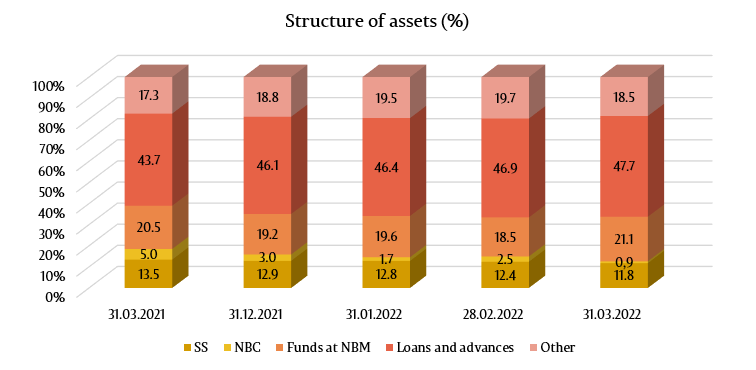During the first quarter of 2022, the National Bank of Moldova (NBM) continued the process of prudential supervision of banks in the Republic of Moldova, pursuing compliance with legal requirements to ensure the stability and viability of the banking system.
The banking sector, in the first quarter of 2022, according to the data presented by the banks, was characterized by high liquidity and by the increase in loans and own funds. The profit for the year compared to the same period of the previous year increased, mainly as a result of the increase in interest income and non-interest income. At the same time, expired loans decreased both in absolute value and as a share of total loans.
The reference period was marked by risks and uncertainties generated by the pandemic crisis, which later overlapped with those triggered by the war in Ukraine. As a result, assets, deposits of individuals and legal entities, and bank deposits all decreased. At the same time, the balance of non-performing loans increased, affecting the quality indicator of the loan portfolio compared to the end of the previous year. However, due to the resilience of the banking sector as a result of reforms in recent years, banks are coping with challenges.
As of March 31, 2022, 11 banks licensed by the National Bank of Moldova operated in the Republic of Moldova. One bank was supervised under the early intervention regime applied on January 11, 2019. Subsequently, by decisions of the Executive Board of the NBM, the term of appointment of the temporary administrators was extended until October 28, 2022.
During the first quarter of 2022, IuteCredit Europe AS (Estonia) acquired the treasury shares of C.B. ENERGBANK AS in the amount of 49.42%. Later, through the Stock Exchange of Moldova and within the public offer, he acquired the shares from several shareholders of B.C. "ENERGBANK" S.A. Thus, currently, A.S. IuteCredit Europe owns 94.58% of the bank's share capital.
Financial situation of the banking sector and compliance with prudential regulations
As of March 31, 2022, the situation in the banking sector, reflected by the reports submitted by banks, registered the following trends:
Assets and liabilities
Total assets amounted to 118.3 billion lei, decreasing by 0.2% (264.0 million lei) during the first quarter of 2022.
The largest share in total assets went to loans and advances at amortized cost, which amounted to 47.7% (56.5 billion lei), increasing by 1.6 percentage points (pp) compared to the end of the previous year.
The share of funds at the NBM was 21.1% (25.0 billion lei), increasing by 1.9 pp. The share of banks' investments in state securities and National Bank certificates (NBC) was 12.7% (14.9 billion lei), decreasing by 3.2 percentage points (pp). The rest of the assets, which account for 18.5% (21.9 billion lei), are kept by banks in other banks, cash, tangible assets, intangible assets, etc. Their share decreased by 0.3 pp.

The gross (prudential) loan balance was 49.1% of total assets, or 58.1 billion lei, and increased by 3.0% (1.7 billion lei) during the examined period. At the same time, the volume of new loans granted during the first quarter of 2022 increased by 16.6% compared to the same period of the previous year.
The largest increase during the first quarter of 2022 was recorded in loans granted for the purchase/construction of real estate, which balance increased by 4.8% (545.7 million lei) to 12.0 billion lei, loans granted to non-banking financial environment - by 25.2% (454.8 million lei) up to 2.3 billion lei, loans granted to food industry - by 6.6% (226.9 million lei) up to 3.6 billion lei and loans granted to individuals performing activity - 19.1% (218.8 million lei) up to 1.4 billion lei.
During the reference period, the share of non-performing loans (substandard, doubtful, and compromised) in total loans increased by 1.0 pp, amounting to 7.1% on March 31, 2022, with the indicator ranging from 2.0% to 11.1%, depending on the bank.
At the same time, non-performing loans in absolute value increased by 18.6% (643.0 million lei), amounting to 4.1 billion lei.
During the examined period, the proportion of expired loans in total loans fell from 3.1% on December 31, 2021 to 2.9% on March 31, 2022.

At the same time, the balance of deposits decreased in the reference period, mainly due to external events. According to prudential reports, it decreased by 6.2 billion lei, or 6.8%, amounting to 83.9 billion lei (deposits of individuals accounted for 61.1% of total deposits, deposits of legal entities - 38.8%, and deposits of banks - 0.1%), due to the decrease of the balance of deposits of individuals by 4.6 billion lei (8.3%) to 51.3 billion lei, deposits of legal entities by 1.5 million lei (4.4%) to 32.5 billion lei, and bank deposits - by 0.04 million lei (26.8%) to 108.4 million lei.
In total deposits, 55.5% went to deposits in lei, their balance decreasing by 5.1 billion lei (9.9%) compared to the end of the previous year and amounting to 46.6 billion lei as of March 31, 2022. Foreign currency deposits accounted for 44.5% of total deposits, and their balance decreased during the reference period by 1.1 billion lei (2.8%), making up 37.3 billion lei (withdrawal of foreign currency deposits - the equivalent of 1.8 billion lei; total revaluation of foreign currency deposits - 719.4 million lei).

Revenues and profits
As of March 31, 2022, the profit in the banking system totalled 799.9 million lei, increasing by 89.4% (377.5 million lei) compared to the same period of the previous year.
The increase in profit was determined by the increase in interest income by 565.5 million lei (50.4%) (mainly from lending activity), income from exchange rate differences - by 143.6 million lei (57.6%), and revenues from fees and commissions - by 107.1 million lei (20.1%). At the same time, non-interest expenses increased by 375.4 million lei (30.9%) and interest expenses - by 72.2 million lei (24.4%).
Total revenues amounted to 2.8 billion lei, increasing compared to the same period of the previous year by 825.1 million lei (42.7%). Of which, interest income accounted for 61.1% (1.7 billion lei) and non-interest income - 38.9% (1.1 billion lei).
At the same time, total expenses amounted to 2.0 billion lei, increasing compared to the same period of the previous year by 447.6 million lei (29.6%). Of which, interest expenses accounted for 18.8% (368.1 million lei) of total expenses, and non-interest expenses - 81.2% (1.6 billion lei) of total expenses.
As of 31.03.2022, return on assets and return on capital accounted for 2.7% and 16.0%, increasing by 0.7 pp. and 3.6 pp., respectively, compared to the same period of the previous year.
Compliance with prudential requirements
Throughout the first quarter of 2022, banks continued to keep liquidity indicators high above regulated limits.
Thus, the value of the long-term liquidity indicator (liquidity principle I) was 0.75 (limit ≤1), ranging from 0.37 to 0.90 and being practically at the same level as at the end of 2021.
Liquidity principle III, which is the ratio between the adjusted actual liquidity and the required liquidity on each maturity band and which should not be less than 1 on each maturity band, has also been complied with by all banks, ranging from 1.34 on the maturity band up to one month inclusive up to 128.09 on the maturity band between one month and three months inclusive.
The sector's liquidity coverage ratio was 258.6% (limit ≥ 80% - starting with 1 January 2022) and ranged from 136.3% to 972.7%, decreasing by 99.9 pp compared to the end of the previous year.
According to the reports presented by banks as of March 31, 2022, the total capital ratio in the banking sector registered a value of 25.7%, with a small decline by 0.2 pp compared to the end of the previous year and ranged between 18.7% and 59.7%. All banks observed the total capital ratio (≥10%).
Also, all banks observed the total capital ratio, considering capital buffers.
As of March 31, 2022, the total own funds amounted to 15.3 billion lei and increased by 1.0% (156.9 million lei).
As of March 31, 2022, banks complied with prudential indicators regarding large exposures and exposures to their affiliates.
Development of the national legislative framework and its alignment with the EU legislation
During the first quarter of 2022, to apply the provisions of Law No. 202/2017 on the activity of banks, the Decision of the Executive Board of the NBM No. 16/2022 amended some normative acts of the National Bank of Moldova. The respective amendments were made to bring some normative acts of the NBM in line with provisions of Regulation No 101/2020 on consolidated supervision of banks, Regulation No. 102/2020 on treatment of counterparty credit risk for banks, Regulation No. 103/2020 on treatment of credit valuation adjustment risk for banks, and Regulation No. 274/2020 on leverage for banks, which transposed the relevant provisions of Regulation No. 575/2013 of the European Parliament and of the Council of June 26, 2013.
The Decision aimed at adjusting the regulatory framework for own funds, large exposures, publication requirements, etc. to the provisions of the acts above in the light of the European framework (Regulation (EU) No. 575/2013, Regulation (EU) No. 241/2014, and Regulation (EU) No. 680/2014).
Thus, Regulation No. 109/2018 on own funds of banks and capital requirements was supplemented by requirements on inclusion in the calculation of own funds, at the consolidated level (inclusion conditions and method of calculation), of minority interests (equity Tier 1 capital instruments held by persons other than the undertakings included in the scope of consolidation, provided for in Regulation No. 101/2020), of additional Tier 1 and Tier 2 own funds instruments, issued by the bank's subsidiaries (parent company of a group under supervision on a consolidated basis), as well as own funds requirements for credit adjustment risk and counterparty risk. At the same time, in the context of prior approval for the distribution of profits to shareholders, inclusion of the option to issue an approval for an amount less than the amount requested by the bank if the amount requested may lead to non-compliance with own funds requirements or other prudential indicators, or to endangering the bank’s stability.
Regulation No. 109/2019 on large exposures was supplemented with provisions to specify some particularities of the exposure value calculation, related to the treatment of counterparty credit risk for banks, in the context of the bank’s large exposures. At the same time, requirements were established for consolidated reporting of the information on the top ten exposures to banks and the top ten exposures to financial sector entities other than banks.
The publication requirements set out in Regulation No. 158/2020 on the requirements for the publication of information by banks were extended by including provisions for the publication of information on the leverage ratio calculated in accordance with Regulation No. 274/2020 on leverage for banks (leverage ratio, a description of the processes used to manage leverage risk).
Instruction No. 117/2018 (COREP) was supplemented with provisions on the terms and method of reporting information related to own funds and large exposures on a consolidated basis, considering the changes included in the regulations above. The initial deadline for consolidated reporting for the fiscal year ending December 31, 2021, was set for June 30, 2022. Subsequent reporting will be done annually, no later than May 31 of the year following the reporting period.
Also, the obligation of banks to comply with the requirements for own funds of banks was determined, as well as the obligations related to the treatment of credit, operational, and market risk not only on an individual but on a consolidated basis as well.
























